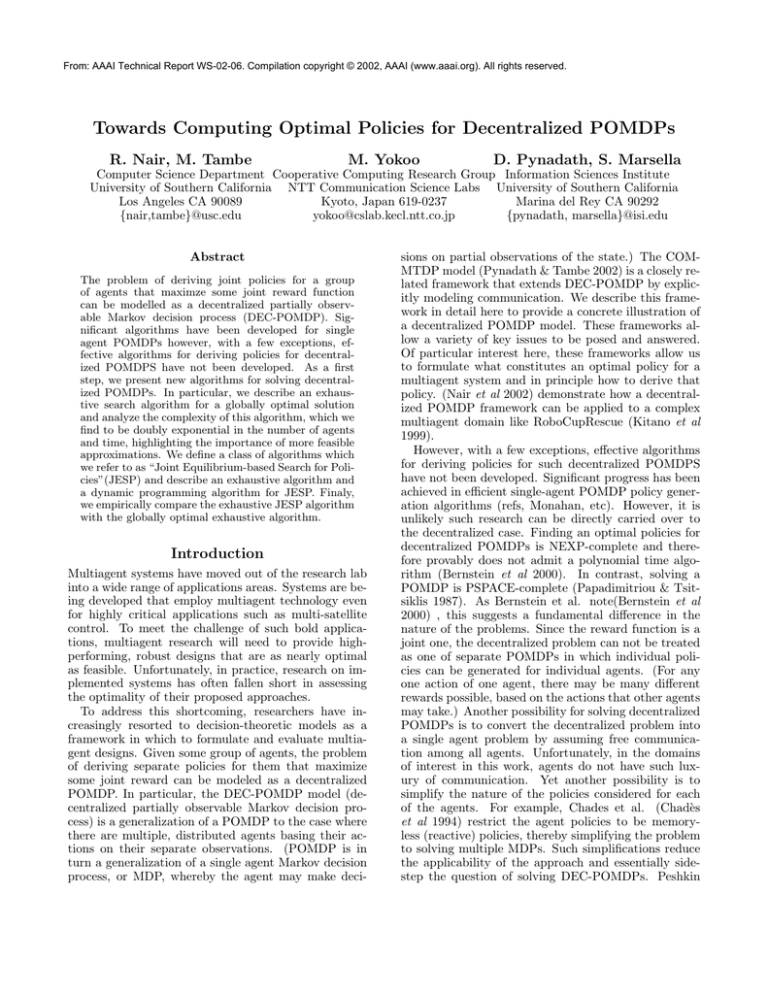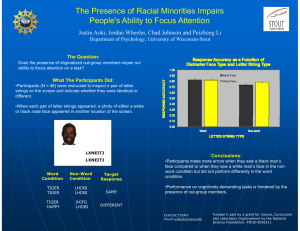
From: AAAI Technical Report WS-02-06. Compilation copyright © 2002, AAAI (www.aaai.org). All rights reserved.
Towards Computing Optimal Policies for Decentralized POMDPs
R. Nair, M. Tambe
M. Yokoo
D. Pynadath, S. Marsella
Computer Science Department Cooperative Computing Research Group Information Sciences Institute
University of Southern California NTT Communication Science Labs University of Southern California
Los Angeles CA 90089
Kyoto, Japan 619-0237
Marina del Rey CA 90292
{nair,tambe}@usc.edu
yokoo@cslab.kecl.ntt.co.jp
{pynadath, marsella}@isi.edu
Abstract
The problem of deriving joint policies for a group
of agents that maximze some joint reward function
can be modelled as a decentralized partially observable Markov decision process (DEC-POMDP). Significant algorithms have been developed for single
agent POMDPs however, with a few exceptions, effective algorithms for deriving policies for decentralized POMDPS have not been developed. As a first
step, we present new algorithms for solving decentralized POMDPs. In particular, we describe an exhaustive search algorithm for a globally optimal solution
and analyze the complexity of this algorithm, which we
find to be doubly exponential in the number of agents
and time, highlighting the importance of more feasible
approximations. We define a class of algorithms which
we refer to as “Joint Equilibrium-based Search for Policies”(JESP) and describe an exhaustive algorithm and
a dynamic programming algorithm for JESP. Finaly,
we empirically compare the exhaustive JESP algorithm
with the globally optimal exhaustive algorithm.
Introduction
Multiagent systems have moved out of the research lab
into a wide range of applications areas. Systems are being developed that employ multiagent technology even
for highly critical applications such as multi-satellite
control. To meet the challenge of such bold applications, multiagent research will need to provide highperforming, robust designs that are as nearly optimal
as feasible. Unfortunately, in practice, research on implemented systems has often fallen short in assessing
the optimality of their proposed approaches.
To address this shortcoming, researchers have increasingly resorted to decision-theoretic models as a
framework in which to formulate and evaluate multiagent designs. Given some group of agents, the problem
of deriving separate policies for them that maximize
some joint reward can be modeled as a decentralized
POMDP. In particular, the DEC-POMDP model (decentralized partially observable Markov decision process) is a generalization of a POMDP to the case where
there are multiple, distributed agents basing their actions on their separate observations. (POMDP is in
turn a generalization of a single agent Markov decision
process, or MDP, whereby the agent may make deci-
sions on partial observations of the state.) The COMMTDP model (Pynadath & Tambe 2002) is a closely related framework that extends DEC-POMDP by explicitly modeling communication. We describe this framework in detail here to provide a concrete illustration of
a decentralized POMDP model. These frameworks allow a variety of key issues to be posed and answered.
Of particular interest here, these frameworks allow us
to formulate what constitutes an optimal policy for a
multiagent system and in principle how to derive that
policy. (Nair et al 2002) demonstrate how a decentralized POMDP framework can be applied to a complex
multiagent domain like RoboCupRescue (Kitano et al
1999).
However, with a few exceptions, effective algorithms
for deriving policies for such decentralized POMDPS
have not been developed. Significant progress has been
achieved in efficient single-agent POMDP policy generation algorithms (refs, Monahan, etc). However, it is
unlikely such research can be directly carried over to
the decentralized case. Finding an optimal policies for
decentralized POMDPs is NEXP-complete and therefore provably does not admit a polynomial time algorithm (Bernstein et al 2000). In contrast, solving a
POMDP is PSPACE-complete (Papadimitriou & Tsitsiklis 1987). As Bernstein et al. note(Bernstein et al
2000) , this suggests a fundamental difference in the
nature of the problems. Since the reward function is a
joint one, the decentralized problem can not be treated
as one of separate POMDPs in which individual policies can be generated for individual agents. (For any
one action of one agent, there may be many different
rewards possible, based on the actions that other agents
may take.) Another possibility for solving decentralized
POMDPs is to convert the decentralized problem into
a single agent problem by assuming free communication among all agents. Unfortunately, in the domains
of interest in this work, agents do not have such luxury of communication. Yet another possibility is to
simplify the nature of the policies considered for each
of the agents. For example, Chades et al. (Chadès
et al 1994) restrict the agent policies to be memoryless (reactive) policies, thereby simplifying the problem
to solving multiple MDPs. Such simplifications reduce
the applicability of the approach and essentially sidestep the question of solving DEC-POMDPs. Peshkin
et al. (Peshkin et al. 2000) use finite-controllers to
represent the partially observable state as an abstraction. However their model does not explicitly model
communication.
Thus, there remains a critical need for new efficient algorithms for generating optimal policies in distributed POMDPs. In this paper, we take a first step,
by presenting new algorithms for solving decentralized
POMDPs, restricted to the case of discrete belief states.
First, we present an exact algorithm in the sense that
it derives the globally optimal policy via a full search
of the space of policies. This exact algorithm is of
course expensive to compute which limits its applicability to problems where there is sufficient time to
off-line pre-compute such an exact solution. Therefore, we also present two approximate algorithms that
search the space of policies incrementally. These algorithms iterate through the agents, finding an optimal
policy for each agent assuming the policies of the other
agents are fixed. These algorithms, which we refer to as
Joint Equilibrium-based Search for Policies (JESP) algorithms, terminate when no improvements to the joint
reward is achieved, thus achieving a local optimum similar to a Nash Equilibrium. We conclude with an empirical evaluation of the algorithms.
Background
The COM-MTDP model (Pynadath & Tambe 2002)
is a formal model based on multiple communicating
POMDPs with joint transition, observation and reward
functions. This model allows us to explicitly reason
about the cost of communication. This is especially
relevant in the search for an optimal solution to a decentralized POMDP because communicating enables
agents to synchronize their beliefs allowing for a more
optimal solution.
The COM-MTDP Model
No Comm.
Gen. Comm.
Free Comm.
Ind. Obs.
P-Comp.
P-Comp.
P-Comp.
Coll. Obs.
NEXP-Comp.
NEXP-Comp.
P-Comp.
Coll. Part. Obs.
NEXP-Comp.
NEXP-Comp.
PSPACE-Comp.
Table 1: Computational Complexity
Individual Observability: Each individual’s observation uniquely determines the world state: ∀ω ∈ Ωi ,
∃s ∈ S such that ∀s = s, Pr(Ωti = ω|S t = s ) = 0.
Agent i chooses its actions and communication based
on its belief state, bti ∈ Bi , derived from the observations andcommunication it has received through time
t. Bα = i∈α Bi is the set of possible combined belief
states. Like the Xuan-Lesser model(Xuan et al 2001),
each decision epoch t consists of two phases. In the first
phase, each agent i updates its belief state on receiving its observation, ωit ∈ Ωi , and chooses a message to
send to its teammates. In the second phase, it updates
its beliefs based on communication received, Σtα , and
then chooses its action. The agents use separate stateestimator functions to update their belief states: initial belief state, b0i = SEi0 (); pre-communication belief
t
state, bti•Σ = SEi•Σ (bt−1
iΣ• , ωi ); and post-communication
t
belief state, biΣ• = SEiΣ• (bti•Σ , Σtα ).
The COM-MTDP reward function represents the
team’s joint utility (shared by all members) over states
and actions, R : S ×Σα ×Aα → R, and is the sum of two
rewards: a domain-action-level reward, RA :S×Aα →R,
and a communication-level reward, RΣ:S×Σα→R. COMMTDP (and likewise R-COM-MTDP) domains can be
classified based on the allowed communication and its
reward:
General Communication: no assumptions on Σα
nor RΣ .
No Communication: Σα = ∅.
Free Communication: ∀σ ∈ Σα , RΣ (σ) = 0.
Given a team of selfless agents, α, a COMMTDP (Pynadath & Tambe 2002) is a tuple,
S, Aα ,
Σα , P, Ωα , Oα , Bα , R. S is a set of world states.
Aα = i∈α Ai is a set of combined domain-level actions,
where Ai is the set of actions for agent i. Σα =
Σ
i∈α i is a set of combined messages, where Σi is the
set of messages for agent i. P (sb , a, se ) = P r(S t+1=
se |S t=sb , Atα
=a) governs the domain-level action’s effects. Ωα = i∈α Ωi is a set of combined observations,
where Ωi is the set of observations for agent i. Observation function, Oα (s, a, ω) = P r(Ωtα=ω|S t=s, At−1
α =a)
specifies a probability distribution over the agents’ joint
observations and may be classified as:
Analyzing the extreme cases, like free communication
(and others in this paper) helps to understand the computational impact of the extremes. Table 1 from (Pynadath & Tambe 2002) shows the worst case computational complexities for various classes of COM-MTDP
domains. In the case of general communication and
partially observable states, the decision problem of determining if there exists a joint policy with expected
reward at least k is NEXP-Complete. The following
sections illustrate algorithms that find a joint policy
for this case.
Collective Partial Observability: No assumptions
are made about the observability of the world state.
When agents do not fully communicate, they must coordinate instead by selecting policies that depend on their
entire histories of observations. Thus, each agent, i, follows a deterministic policy of behavior, πi : Ω∗i → A,
that maps a sequence of its individual observations into
an action. We define a joint policy, πα , for a team, α,
Collective Observability: Team’s combined observations uniquely determines world state: ∀ω ∈ Ωα ,
∃s ∈ S such that ∀s = s, Pr(Ωα t = ω|S t = s ) = 0.
Optimal Joint Policy
as a combination of such individual policies for each
member of α. The problem facing the team is finding the optimal joint policy—i.e., the joint policy that
maximizes the team’s expected reward.
One sure-fire method for finding the optimal joint
policy is to simply search the entire space of possible
joint policies, evaluate the expected reward of each, and
select the policy with the highest such value. To perform such a search, we must first be able to determine
the expected reward of a joint policy. In computing this
expectation, we must consider all of the branches, for
both different world states and different observations,
that occur at each time step. In general, for a team
α = {1, . . . , n} and for a horizon T , we can compute its
expected reward when following a joint policy, π α , by
expanding all possible paths of execution. In the initial time step, we can express the value of the policy as
follows:
Vπα = P (·, ·, s0 ) ·
···
O α (s0 , ·, ω10 , . . . , ωn0 )
s0 ∈S
ω10 ∈Ω1 ωn0 ∈Ωn
· [R(s0 , π1 (ω10 ), . . . , πn (ωn0 ))
+Vπ1α (s0 , ω10 , . . . , ωn0 )
πn
·
ωn0 , . . . , ωn(t−1)
, st
(1)
···
O α st , π1 ω10 , . . . , ω1(t−1) , . . . ,
ω1t ∈Ω1 ωnt
∈Ωn
. πn
ωn0 , . . . , ωn(t−1)
, ω1t , . . . , ωnt ·[R(st , π1 (ω10 , . . . , ω1t ), . . . , πn (ωn0 , . . . , ωnt ))
+ Vπt+1
(st , ω10 , . . . , ω1t , . . . , ωn0 , . . . , ωnt )]
α
(2)
We terminate this recursion at the end of the finite
horizon, where:
VπTα+1 (sT , ω10 , . . . , ω1T , . . . , ωn0 , . . . , ωnT )
=0
to be the largest such state sizes over all the agent team
members. The time complexity for finding the optimal
joint policy by searching this space is thus:
O
|A∗ |
|Ω∗ |T −1
|Ω∗ |−1
|α|
T
· (|S| · |Ωα |)
Thus, the time complexity of this exhaustive method
for finding an optimal joint policy is exponential in the
number of possible observations, |Ω∗ |, exponential in
the number of agents, |α|, and doubly exponential in
the time horizon, T .
Approximate Algorithms
This expression represents the expected immediate reward earned at time 0 and the future value of executing
policy, π α , from time 1 onward. We represent the latter
as Vπ1α , which is a function of the current state of the
world and the individual agents’ observations. For all
times t ≤ T , we can express this function as:
Vπt α (st−1 , ω10 , . . . , ω1(t−1) , . . . , ωn0 , . . . , ωn(t−1) )
= P st−1 , π1 ω10 , . . . , ω1(t−1) , . . . ,
st ∈S
joint policy. Since each policy specifies different actions over possible histories of observations, the number of possible policies for an individual agent i is
|Ωi |T −1
O |Ai | |Ωi |−1 . The number of possible joint policies
|α| |Ω∗ |T −1
is thus O
|A∗ | |Ω∗ |−1
, if we take |A∗ | and |Ω∗ |
(3)
At each time step, the computation of Vπt α performs a summation over all possible world states and
agent observations,
so the time complexity of this algo
rithm is O |S| · |Ωα |T +1 . The overall search performs this computation for each and every possible
Given the complexity of exhaustively searching for the
optimal joint policy, it is clear that such methods will
not be successful when the amount to time to generate the policy is restricted. In this section, we will
present any-time approximation algorithms that are
guaranteed to find a locally optimal joint policy. We
refer to this category of algorithms as “Joint ESP”
(Joint Equilibrium-Based Search for Policies). The solution obtained is closely related to (i) PBP(Personby-Person) in team theory; (ii) Nash equilibrium from
cooperative and non-cooperative game theory. The key
idea is to find the policy for one agent at a time, keeping
the policies of all the other agents fixed, that maximizes
the joint expected reward. This process is repeated until an equilibrium is reached (local optimum is found).
Exhaustive approach for Joint ESP
This algorithm below describes an exhaustive algorithm
for Joint ESP. Here we consider that there are n cooperative agents. We modify the policy of one agent at a
time keeping the policies of the other n − 1 agents fixed.
The function bestPolicy, returns the joint policy that
maximizes the expected joint reward, obtained by keeping n − 1 agents’ policies fixed and exhaustively searching in the entire policy space of the agent whose policy
is free. At each iteration, the value of the modified joint
policy will either increase or remain unchanged (within
some threshold of the previous joint policy’s value).
This is repeated until an equilibrium is reached, i.e., the
policies of all n agents remains unchanged. This policy
is guaranteed to be a local maximum since the value of
the new joint policy at each iteration is non-decreasing.
ExhaustiveJointESP()
n: number of agents
: threshold for convergence
prev: previous joint policy, initially randomly set
convCount: count to indicate if convergence has
taken place, initially 0
1. while convCount = n − 1
2. for i ← 1 to n
3.
fix policy of all agents except i
4.
policySpace← list of all possible policies for
i
5.
new ← bestPolicy(i,policySpace,prev)
6.
prev ← new
7.
if new.value - prev.value < 8.
convCount←convCount + 1
9.
else
10.
convCount←0
11. if convCount = n − 1
12.
break
13. return new
This algorithm has the same worst case complexity
as the exhaustive search for a globally optimal policy.
However, this algorithm could end up in a local optimum. Techniques like simulated annealing can be applied to perturb the solution found to see if it settles
on a different higher value. In the following section
we describe a dynamic programming alternative to this
exhaustive approach for doing Joint ESP.
Introducing Dynamic Programming for
Finding an Optimal Policy
Basic Ideas In this section, we describe a dynamicprogramming like method for finding an optimal policy
for agent 1, assuming that agent 2’s policy π2 is determined. As discussed in previous sections, we cannot
describe a policy of an agent as a function of its belief
state. Therefore, we cannot use standard value iteration methods. However, we can still utilize a dynamicprogramming like method since the principle of optimality holds. More specifically, assume we have a kstep optimal policy. If we take a part of this policy for
last j steps, then this policy must be the optimal policy for remaining j steps, given the history of first k − j
steps. In this section, we show how to define a value
function, which is defined on possible histories agent 1
might encounter.
Notations
• Assume we are designing the policy of agent 1, while
the policy of agent 2, π2 is fixed.
• A reward function: R(s, (a1 , a2 )) is the immediate
reward for performing joint action (a1 , a2 ) at state s.
• transition function: P (si , (a1 , a2 ), sf ) represents the
probability of the current state is sf , if the previous
state is si and the previous joint action is (a1 , a2 ).
• history: history ht is a sequence of t pairs
of an action and an observation, i.e., ht =<
(a1 , w1 ), (a2 , w2 ), . . . , (at , wt ) >
• A state transition history St , which is a sequence of
t states < S1 , S2 , . . . , St >.
• A belief state over state transition histories BSt . Let
us denote the probability that St occurs as B(St )
Details of Dynamic Programming Method
• For a given history ht−1 and a state transition
history St , we can calculate the probability agent
2 has observed a sequence of observations ot−1 ,
P (ot−1 |ht−1 , St ).
Also, given an observation history ot−1 , agent 2’s t-th
action is determined. We denote this as a2 (ot−1 ).
P (ot−1 |ht−1 , St ) =
O2 (Si , (ai1 , a2 (oi−1 )), ωi )
1≤i≤t−1
where Si is the i-th state in St , ai1 is the i-th action in
ht−1 , and oi−1 is the first i − 1 observations in ot−1 .
• For a given history ht−1 and initial synchronized belief state binit , we can calculate the current belief
state over state transition histories BSt .
B(St ) can be incrementally calculated as follows.
B(S1 ) = binit (S1 )
B(Si+1 ) = B(Si )
P (oi−1 |hi−1 , Si ) · O1 (Si , (ai1 , a2 (oi−1 )), ω1i )
oi−1
· P (Si , (ai1 , a2 (oi−1 )), Si+1 )/
B(Si ) P (oi−1 |hi−1 , Si ) · O1 (Si , (ai1 , a2 (oi−1 )), ω1i )
Si
oi−1
where ai1 , ω1i is i-th action and observation in ht−1 .
• S is a set of world states {1, 2, . . . , m}
• Assume we are designing a k step policy.
• A1 , A2 , are set of action for agent 1 and 2. a joint
action is represented as (a1 , a2 ).
• We define a value function Vj , which is a function
of a history hk−j . Vj (hk−j ) represents the expected
reward for taking an optimal policy for remaining j
steps after history hk−j .
• Ω1 , Ω2 are set of observations for agent 1 and 2.
• Observation functions: O1 and O2 . Oi (s, (a1 , a2 ), ωi )
represents the probability of observing ωi , if the current state is s and the previous joint action is (a1 , a2 ).
For notation simplicity, we define another observation
function O1 and O2 , where Oi (s, (a1 , a2 ), ωi ) represents the probability of observing ωi , after performing joint action (a1 , a2 ) at state s.
• Vj is derived from
maxa1 ∈A1 Vja1 (hk−j ).
Vja1 ,
i.e.,
Vj (hk−j )
• V1a1 is defined as follows.
V1a1 (hk−1 ) = ER(a1 |hk−1 )
=
• Vja1 is recursively defined as follows.
consider two cases of the reward function, where we
vary the penalty for jointly opening the door to the
Vja1 (hk−j ) = ER(a1 |hk−j ) +
tiger. The exact problem specification is as described
in Fig. 1. Fig. 1(a) describes the transition probabilik−j
k−j
P (ω1 |h , a1 ) · Vj−1 (< h , (a1 , ω1 ) ties
>) for each state transition given start state and joint
ω1 ∈Ω1
action, Fig. 1(b) describes the observation probabilities
for each joint observation given state and joint action
t−1
t
t−1 t−1
t
last performed and Figs. 1(c) and 1(d) describe the two
ER(a1 |h ) =
B(S ) · P (o |h , S )
reward functions A and B that we use to evaluate the
t
t−1
S o
algorithms in section 3 and 4.1.
·R(St , (a1 , a2 (ot−1 )))
Evaluation Results
We ran the exhaustive globally optimal algorithm(sect
3) and the Exhaustive JESP algorithm(section 4.1) for
k−j
k−j+1
k−j k−j
k−j+1 the multiagent tiger problem using the specifications
P (ω1 |h , a1 ) =
B(S
) · P (o |h , S
)
provided in Fig. 1. Finding the globally optimal policy
Sk−j+1ot−1
is extremely slow for this problem and is exponential in
k−j
·O1 (Sk−j+1 , (a1 , a2 (o )), ω1 )
the finite horizon, T. Hence, we evaluate the algorithms
only for finite horizons of 1 and 2. Fig 2 shows the
Experimental Results
results of this evaluation. We ran the JESP algorithm
for 5 different randomly selected initial policy settings.
In this section, we perform an empirical comparison of
We compare the performance of the algorithms in terms
the algorithms described in sections 3 and 4.1 in terms
of the number of policy evaluations that were necessary
of time and performance. We are currently working on
and in terms of the expected value of the policy.
an implementation of the dynamic programming apFig. 2(a), shows the results of running the globally
proach. The following subsections describes the experoptimal algorithm and the Exhaustive JESP algorithm
imental setup and the results.
using reward function A for finite horizon=1. As can be
Experimental Description
seen from this figure, the JESP algorithm requires much
fewer evaluations to arrive at an equilibrium. Also the
We consider a multiagent version of the classic tiger
policy at equilibrium is the same as the globally optiproblem that has been used in order to explain apmal policy for this particular setting. The difference
proaches to solving single agent POMDPs(Cassandra
in the run times of the globally optimal algorithm and
et al 1994). Our modified version of the problem is as
the JESP algorithm is more apparent when the finite
follows:
horizon=2 (See Fig. 2(b)). Here the globally optimal alTwo agents are in a corridor facing two doors:”left”
gorithm performed 531441 policy evaluations while the
and “right”. Behind one door lies a hungry tiger and
JESP algorithm did fewer than 3000 evaluations. In
behind the other lies untold riches but the agents don’t
this case, too, JESP succeeded in finding the globally
know the position of either. The agents can jointly or
optimal policy. However, this is not always the case.
individually open either door. If either of them opens
Fig. 2(c), shows the results of running the globally opthe door behind which the tiger is present they are attimal algorithm and the Exhaustive JESP algorithm
tacked by the tiger, however the injury sustained if the
using reward function B for finite horizon=1. Here, the
opened the door to the tiger is less severe if they open
JESP algorithm often settles on a locally optimal policy
that door jointly. Similarly, they receive wealth when
that is different from the globally optimal policy.
they open the door to the riches in proportion to the
Based on Fig 2, we can conclude that the exhausnumber of agents that opened that door. The agents
tive
JESP algorithm performs better than an exhauscan independently listen for the presence of the tiger at
tive search for the globally optimal policy but can some
a small cost. If the tiger is behind the left door and the
times settle on a policy that is only locally optimal.
agent has listened, the agent received a . The agents
This could be sufficient for problems where the differcannot communicate with each other at all. Further we
ence between the locally optimal policy’s value and the
assume that every time either agent opens either one of
globally optimal policy’s value is small and it is imperathe doors, the riches and the tiger are randomly repositive that a policy be found quickly. The JESP algorithm
tioned and the agents have to solve the problem again.
can be altered so that it doesn’t get stuck in a local opThis problem can be generalized to n agents but we will
timum using techniques like simulated annealing.
only consider the 2 agent problem here.
Clearly, acting jointly is beneficial because the agents
Summary and Conclusion
receive more riches and sustain less damage if they
acted together. However, because the agents receive inDecentralized POMDPs can be used as a decision theodependent observations and cannot communicate, they
retic model for many multiagent problems highlighting
need to consider the observation histories of the other
the importance of finding algorithms for solving decenagent and what action they are likely to perform. We
tralized POMDPs. Most of the work in the literature
Action/Transition
Tiger Left ← Tiger Left
Tiger Left ← Tiger Right
Tiger Right ← Tiger Right
Tiger Right ← Tiger Left
<Open Right,Open Right>
<Open Left,Open Left>
<Open Right,Open Left>
<Open Left,Open Right>
<Listen,Listen>
<Listen,Open Right>
<Open Right,Listen>
<Listen,Open Left>
<Open Left,Listen>
0.5
0.5
0.5
0.5
1.0
0.5
0.5
0.5
0.5
0.5
0.5
0.5
0.5
0.0
0.5
0.5
0.5
0.5
0.5
0.5
0.5
0.5
1.0
0.5
0.5
0.5
0.5
0.5
0.5
0.5
0.5
0.0
0.5
0.5
0.5
0.5
(a)
Action
State
<Tiger Left,Tiger Left>
<Tiger Left,Tiger Right>
<Tiger Right,Tiger Right>
<Tiger Right,Tiger Left>
<Listen,Listen>
<Listen,Listen>
<Open Right,Open Right>
<Open Left,Open Left>
<Open Right,Open Left>
<Open Left,Open Right>
<Listen,Open Right>
<Open Right,Listen>
<Listen,Open Left>
<Open Left,Listen>
Tiger Left
Tiger Right
*
*
*
*
*
*
*
*
0.7225
0.0225
0.25
0.25
0.25
0.25
0.25
0.25
0.25
0.25
0.1275
0.1275
0.25
0.25
0.25
0.25
0.25
0.25
0.25
0.25
0.0225
0.7225
0.25
0.25
0.25
0.25
0.25
0.25
0.25
0.25
0.1275
0.1275
0.25
0.25
0.25
0.25
0.25
0.25
0.25
0.25
(b)
Action/State
Tiger Left
Tiger Right
<Open Right,Open Right>
<Open Left,Open Left>
<Open Right,Open Left>
<Open Left,Open Right>
<Listen,Listen>
<Listen,Open Right>
<Open Right,Listen>
<Listen,Open Left>
<Open Left,Listen>
+20
-50
-100
-100
-2
+9
+9
-101
-101
-50
+20
-100
-100
-2
-101
-101
+9
+9
Action/State
Tiger Left
Tiger Right
<Open Right,Open Right>
<Open Left,Open Left>
<Open Right,Open Left>
<Open Left,Open Right>
<Listen,Listen>
<Listen,Open Right>
<Open Right,Listen>
<Listen,Open Left>
<Open Left,Listen>
+20
-50
-100
-100
-2
+9
+9
-101
-101
0
+20
-100
-100
-2
-101
-101
+9
+9
(c)
(d)
Figure 1: (a) Transition function; (b) Observation function; (c) Reward function A;(d)Reward function B
JESP
JESP
JESP
JESP
JESP
Policy
Policy
Policy
Policy
Policy
Joint Policy
Globally Optimal Policy
(at start, Agent1←Policy1,Agent2←Policy7)
(at start, Agent1←Policy4,Agent2←Policy8)
(at start, Agent1←Policy4,Agent2←Policy7)
(at start, Agent1←Policy6,Agent2←Policy8)
(at start, Agent1←Policy8,Agent2←Policy6)
Number of evaluations
81
27 (3 iterations)
18 (2 iterations)
27 (3 iterations)
18 (2 iterations)
27 (3 iterations)
Value
-2
-2
-2
-2
-2
-2
(a)
JESP
JESP
JESP
JESP
JESP
Policy
Policy
Policy
Policy
Policy
(at
(at
(at
(at
(at
Joint Policy
Globally Optimal Policy
start, Agent1←Policy275,Agent2←Policy713)
start, Agent1←Policy140,Agent2←Policy522)
start, Agent1←Policy245,Agent2←Policy523)
start, Agent1←Policy678,Agent2←Policy310)
start, Agent1←Policy421,Agent2←Policy720)
Number of evaluations
531441
1458 (2 iterations)
2187 (3 iterations)
2187 (3 iterations)
2187 (3 iterations)
1458 (2 iterations)
Value
-4
-4
-4
-4
-4
-4
(b)
JESP
JESP
JESP
JESP
JESP
Policy
Policy
Policy
Policy
Policy
Joint Policy
Globally Optimal Policy
(at start, Agent1←Policy7,Agent2←Policy4)
(at start, Agent1←Policy0,Agent2←Policy3)
(at start, Agent1←Policy1,Agent2←Policy5)
(at start, Agent1←Policy6,Agent2←Policy8)
(at start, Agent1←Policy5,Agent2←Policy6)
Number of evaluations
81
18 (2 iterations)
27 (3 iterations)
27 (3 iterations)
18 (2 iterations)
27 (3 iterations)
Value
10
10
-2
-2
-2
-2
(c)
Figure 2: Evaluation Results for (a) Reward A, Horizon = 1; (b) Reward A, Horizon = 2; (c) Reward B, Horizon =
1
is restricted to the single agent POMDP case and does
not directly apply because the decentralized problem
is much harder. Most algorithms for solving decentralized POMDPs make some simplifying assumptions
that restrict their applicability and do not explicitly
model communication amongst the agents. To overcome these shortcomings, we present a formal model,
COM-MTDP (Pynadath & Tambe 2002), that can explicitly reason about communication (when and what
to communicate).
We then describe a exhaustive search algorithm for
a globally optimal solution and analyze the complexity
of this algorithm, which we find to be doubly exponential in the number of agents and time, highlighting
the importance of more feasible approximations. We
then describe a class of algorithms which we refer to as
“Joint Equilibrium-based Search for Policies” that will
find a local optimum and describe an exhaustive algorithm and a dynamic programming algorithm for JESP.
We empirically compared the exhaustive JESP algorithm with the globally optimal exhaustive algorithm
for a 2 agent “tiger problem”. For this problem it was
found that the JESP algorithm was much faster than
the global search. Simulated Annealing like techniques
can be used to prevent the exhaustive JESP algorithm
from getting stuck in a local optimum.
References
Bernstein, D. S.; Zilberstein, S.; and Immerman, N. 2000.
The complexity of decentralized control of MDPs. In UAI00.
Cassandra, A. R.; Kaelbling, L. P.; and Littman, M. L.
1994. Acting optimally in partially observable stochastic
domains. In AAAI-1994.
Chadès, I.; Scherrer, B.; and Charpillet, F. 1994. A heuristic approach for solving decentralized-pomdp: Assessment
on the pursuit problem. In SAC-2002.
Kitano, H. et al. 1999. Robocup-rescue: Search and rescue for large scale disasters as a domain for multiagent
research. In IEEE Conference SMC-99.
Nair, R.; Tambe, M.; and Marsella, S. 2002. Team
formation for reformation in multiagent domains like
RoboCupRescue. In RoboCup Symposium.
Papadimitriou, C. H., and Tsitsiklis, J. N. 1987. Complexity of markov decision processes. Mathematics of Operatios
Research 12(3):441–450.
Peshkin, L.; Meuleau, N.; Kim, K.-E.; and Kaelbling, L.
2000. Learning to cooperate via policy search. In UAI2000.
Pynadath, D., and Tambe, M. 2002. Multiagent teamwork:
Analyzing the optimality complexity of key theories and
models. In AAMAS-02.
Xuan, P.; Lesser, V.; and Zilberstein, S. 2001. Communication decisions in multiagent cooperation. In Agents-01.








